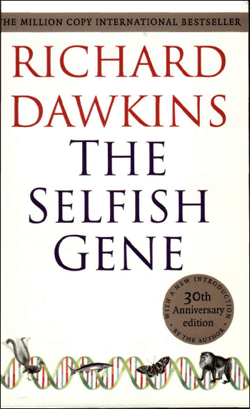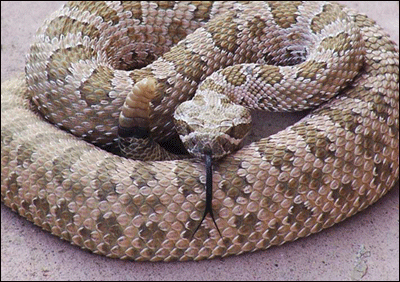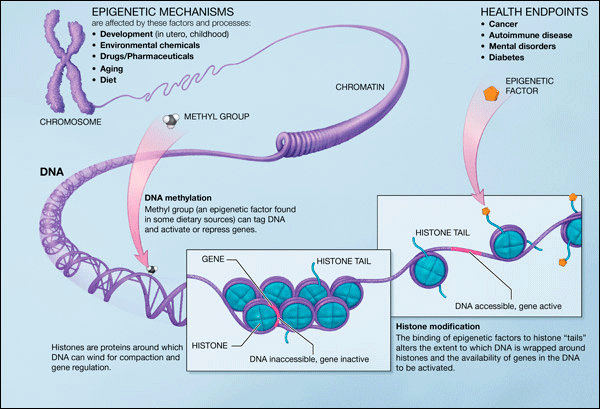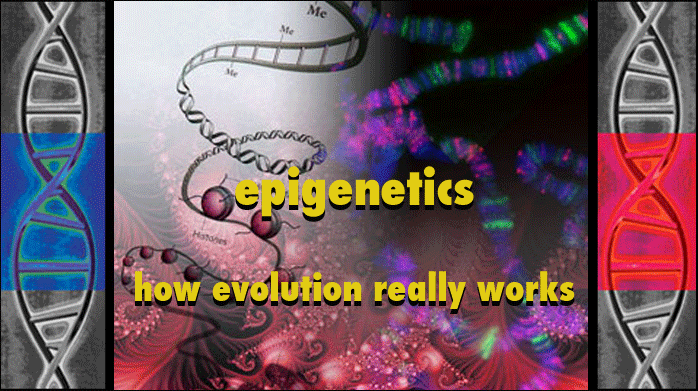A farmer I know often goes out to shoot possums that invade his garden in the middle of the night. His dog chases them up a tree and, with a flashlight reflecting in their eyes, they are easy to spot and dispatch. But not always. Increasingly, more possums are apparently learning not to look at the light and they remain invisible -- and continue to live. He joked that this was an example of natural selection, with nature favoring the successful strategy for survival.
On the surface this seems to make sense. But does it really?
Offspring inherit lots of characteristics from their parents' DNA. There are genes for size, hair color and brain development -- but was there really somewhere in the possum's genes a code that stored the strategy of not looking at the hunter's flashlight?
This is not a new question. Survival behaviors of animals have been studied by many researchers, but their inherent programming has never been fully explained. How exactly is this strategy coded and passed on from one generation to the next? How do spiders, for example, know how to build a web or a bird know how to build a nest? Can DNA do this?
The most famous study of survival strategies is outlined in Richard Dawkin's book, The Selfish Gene. Let's take look.
Evolutionay Stable Strategies (ESS)
 One of the most interesting ideas in The Selfish Gene originated from another researcher, Maynard Smith. He described what he termed Evolutionary Stable Stategies, or ESS. These are programmed behaviors which specific species use when they are threatened. These strategies are not taught or learned. They are carried out unconsciously by each organism in a particular species, suggesting that they are imparted to each generation at birth through genes.
One of the most interesting ideas in The Selfish Gene originated from another researcher, Maynard Smith. He described what he termed Evolutionary Stable Stategies, or ESS. These are programmed behaviors which specific species use when they are threatened. These strategies are not taught or learned. They are carried out unconsciously by each organism in a particular species, suggesting that they are imparted to each generation at birth through genes.
Smith listed five main strategies which are observed in the animal kingdom (including humans):
The Hawk -- If threatened, attack and fight to the end. This strategy is to fight an opponent with the maximum effort, unrestrained and for as long as it takes to either win the battle or to quit because of death or injury. Dog and cock fights are examples of this kind of aggressive strategy. While one party will always win, the other party will suffer extreme losses, and possibly death.
The Dove -- If threatened, threaten back but never fight. Run away if attacked. This strategy involves making threatening gestures but inflicting no real harm to the opponent. The threats are usually a kind of ritual or symbolic "gesture" which continues until one of the animals doing this gets tired, bored or simply gives up. No one is injured, one party wins, but often there is a loss of energy and time if each animal has equal stamina.

The Retaliator -- If threatened, act like a dove. But if seriously attacked, respond like a hawk and fight to the end. In this strategy, the animal reacts differently to the threat, depending on which strategy is being used against it. If it encounters a dove, it will respond with a dove strategy and threaten with gesture. But if it encounters a hawk, it will act like a hawk, aggressively fighting to the end. By acting initially as a dove, actual conflict and injury is avoided when the threat is small. But if there is to be a fight, the risk of injury or death is significant.
The Bully -- Act like a hawk when threatened (and hope the opponent is scared away). But if challenged, run away like a dove. This strategy works pretty well as the animal can "fake" that it is willing to fight to the death. And if it comes to a fight, it runs away to safety. The survival potential of the bully is pretty good, unless it encounters a real hawk.
The Prober Retaliator -- Act like a retaliator with most encounters...but be unpredictable and sometimes switch to the hawk strategy -- even if the opponent is a dove! This is perhaps the most successful strategy for some animals because the outcome of an encounter with them is uncertain. Other animals will think twice before challenging them.
Do any of these strategies sound familiar to you? They are exhibited in human competition, such as gaming (poker), government policies and even war games. The last one, Prober Retaliator, is the tactic used by many terrorist organizations.
Not every strategy is the best for all animals. The strategy used by a particular species is determined by which outcome enables optimal survival and more replication of its own kind. It varies depending on the size and strength of the animals, the potential enemies it might encounter and the environment it lives in. Somehow, each species finds the precise strategy that maintains its numbers in a stable, viable population. When it is carefully analyzed, it is always the best choice for that particular species.
While these strategies are interesting in themselves, the fact that they seem to be intelligently designed and unconsciously implemented by the species is even more so. But... designed by whom? And transmitted to each generation by what means?
|
A maze of possibilities
 There is some evidence that strategic behavior can be transmitted by genes. A classic example is Tryon's experiment on the maze-running ability in rats [1][2]. Tryon managed to breed two groups of rats by selectively mating the "best" maze runners with each other and, conversely, the "worst" maze runners. After seven generations he could show that he had produced two distinct heredity groups with a vast innate differences in their maze running abilities. This was believed by many to be proof that behavior was inherited, and therefore a product of DNA. But his results were soon challenged.
There is some evidence that strategic behavior can be transmitted by genes. A classic example is Tryon's experiment on the maze-running ability in rats [1][2]. Tryon managed to breed two groups of rats by selectively mating the "best" maze runners with each other and, conversely, the "worst" maze runners. After seven generations he could show that he had produced two distinct heredity groups with a vast innate differences in their maze running abilities. This was believed by many to be proof that behavior was inherited, and therefore a product of DNA. But his results were soon challenged.
When the "worst" maze runners were subjected to an enriched environment with more objects to explore and more social interactions to enjoy, their maze running abilities were restored. What's more interesting is that their offspring continued to have improved maze running abilities -- even without the stimulating activities [3]. In just one generation this "inherited" deficit was earased. This result suggested that the maze running ability was the product of an interaction of genes and environment, where the genetic effect is only seen under some environmental conditions. If that is true, how can genes change so quickly -- even in the same organism?
Small changes have big results
Scientists continued to examine how small genetic changes could alter complex behavior. Their first success was in explaining how an animal could be programmed to be more "hawkish" or "dovish". As reported in Principles of Neural Science (1992):
"Most animals, including humans, become aggressive when threatened, such as when their territory is invaded, their offspring are attacked, or sexual interactions are prevented. The importance of serotonergic transmission in aggressive behavior is clearly evident in studies of mice in which the gene for the serotonin 1B receptor has been ablated by targeted deletion.
When mice lacking serotonin 1B receptor are isolated for four weeks and then exposed to a wild-type mouse, they are much more aggressive than wild-type animals under similar conditions. The mutant mice attack intruders faster than wild-type mice or mice lacking only one copy of serotonin 1B receptor gene, and the number and intensity of attacks is significantly greater than that of the wild-type mice. Thus, the serotonin 1B receptor plays a role in mediating aggressive behavior in mice...
[4]
While the mechanism for generalized behavior strategies (like being more or less aggressive) seemed to implicate genes and their ability to alter certain neurotransmitters, it was still not known how genes could also modify specific behaviors -- like making the possum turn its eyes from the hunter's flashlight.
Some amazing examples of genetically encoded, complex behaviors have been studied in monozygotic twins -- siblings with the exact copies of their DNA -- who were separated at birth and reared in different environments.
Identical Twins Reared Apart
Human monozygotic (MZ) twins account for 1 in 250 live births. The origin of MZ twins is attributed to two or more daughter cells of a single zygote (fertilized egg) undergoing independent cell divisions, leading to independent development and births.
Although they are considered genetically identical at birth, significant differences between MZ twins may exist, becoming more evident with age. But the main focus of study has been on the remarkable similarities which involve complex behaviors, personality and interests. These are, after all, strategies that humans use to survive conflicts.
The Minnesota Twins, as they are known, are perhaps the most reported case involving two male babies who were monozygotic twins, separated at when they were only 4 months old, and each adopted by a different family.

At age five, Lewis learned that he had a twin, but he said that the notion never truly "soaked in" until he was 38 years old. Springer learned of his twin sibling at age eight, but both he and his adoptive parents believed the sibling had died. The two were finally reunited at age 39. The similarities the twins shared not only amazed one another, but researchers at the University of Minnesota as well. The very fact that you had twin siblings separated at birth bearing the same name, both 6 feet tall and weighing exactly 180 pounds is pretty incredible. But there's more.
Consider these coincidences:
- As youngsters, each Jim had a dog named "Toy."
- Each Jim had been married two times -- the first wives were both called "Linda" and the second wives were both called "Betty."
- One Jim had named his son "James Allan" and the other Jim had named his son "James Alan."
- Each twin had driven his light-blue Chevrolet to Pas Grille beach in Florida for family vacations.
- Both Jims smoked Salem cigarettes and drank Miller Lite beer.
- Both Jims had at one time held part-time posts as sheriffs.
- Both were fingernail biters and suffered from migraine headaches.
- Each Jim enjoyed leaving love notes to his wife throughout the house.
- Both Jims had abilities in mechanical drawing and carpentry
The Jims, like other identical twins, are not carbon copies of each other. Some obvious differences were discovered. Each styled his hair differently; one Jim wore it combed straight, hanging down over his forehead and the other Jim wore it combed back and sported sideburns. One Jim more clearly conveyed himself through speech, while the other was better suited to writing. While both Jims had been married twice, one Jim had taken vows with a third wife (called "Sandy").
Daphne and Barbara are also examples of subtle behaviors that are apparently transmitted through genes.
 Daphne Goodship and Barbara Herbert first met when they were 40. Debbie was raised Jewish and Sharon was raised Catholic. Daphne Goodship and Barbara Herbert first met when they were 40. Debbie was raised Jewish and Sharon was raised Catholic.
According to Barbara, "We discovered we had a miscarriage the same year, followed by two boys and a girl in that order."
They joke that they've also cooked the same meal from the same recipe book on the same day, without knowing it. Daphne and Barbara have been called the "giggle twins" because they laugh and fold their arms the same way.
 Identical twins Tom Patterson and Steve Tazumi met four years ago.
Tom is from rural Kansas, he was raised Christian and his parents were janitors. Steve, raised as a Buddhist, lives in Philadelphia. His father was a pharmacist. Identical twins Tom Patterson and Steve Tazumi met four years ago.
Tom is from rural Kansas, he was raised Christian and his parents were janitors. Steve, raised as a Buddhist, lives in Philadelphia. His father was a pharmacist.
However, Tom and Steve chose the same careers. "It's phenomenal," says Steve. "He owned a body building gym and I owned a body building gym. We're both 100 percent into fitness."
But there are differences in these twins, too. Steve says he's more party oriented while Tom is more family oriented.
Heredity vs Environment
Although there is ample documentation for these similar personality traits in identical twins, it is not without some controversy. In her book Identical Twins Reared Apart: A Reanalysis, Susan Farber noted that many of the cases studied were based on subjects who were recruited by asking television viewers to refer people who were identical twins. She claimed that these twins would have been the most obvious to look and act similar. In other words, the selection was not unbiased. She attempted to set the record straight and based her own research on a study that selected twin births from the Danish registry, between 1954 and 1959, and found 12 identical twins that were reared apart.
Farber summarized her review by stating that identical twins who shared the same home life were almost 80% similar, while those reared apart were only 60% alike. Although this certainly proves that environment has a role in shaping behavior, it still makes a strong case for genetics. In the examples above, interests, professions, and even the way we laugh seems to be encoded in our genes. Yet, the environment can modulate this genetic expression. How is that achieved?
|
Epigenetics: the new frontier
If the genes can be likened to long list of instructions, we have learned that some of these instructions can be marked "to do" (activated) or "ignore" (inhibited). Scientists have recently come to understand that, although the list itself remains intact, the various instructions undergo activation and inhibition in a process called epigenetics.
This process is vital when a single fertilized egg (zygote) divides and the cells differentiate to become muscle, tissue, nerve cells skeletal cells, etc. Each different type of cell requires a different set of proteins and different sets of instructions are activated or inhibited. These sets of instructions stabilize and continue over the life of the cell and over many generations as the cell divides and reproduces.
|
Epigenetics is the result of turning a set of DNA instructions on (activated) or off (inhibited).

The process is well understood for the methylation process, where a molecule containing one atom of carbon and three atoms of hydrogen (CH3) attaches to specific genes to turn them off (inhibit) and prevent their instructions from being used to make specific proteins.
The histone modification of genes is less understood but involves a molecule that attaches to part of the gene, causing it to deform and interfering with its ability to make a specific protein -- essentially turning it off.
The attachment of these switching molecules is achieved through the control of ion charges at the specific site. The charges then facilitate the molecular bond and inhibit the gene from replicating and producing its specific protein [8].
The production of specific proteins is critical to life and even minor changes at the genetic level can have dramatic consequences. Much of our genetic code is not completely understood and so-called "junk DNA" may contain instructions that have very specific roles to play in our behavior and thinking.
In our earlier example of the possum, it is possible that some kind of epigenetic change causes increased light sensitivity, making the possum turn its head to avoid the glare of the hunter's flashlight. This subtle change in gene expression becomes a survival strategy and is passed on to offspring.
|
Scientists were surprised to discovered that epigenetics was an on-going process, not limited to differentiating cell types. In fact, they found that environmental factors, such as toxins, temperature or the availability or scarcity of food, could cause epigenetic changes that modified the behavior and form of the organism. These adaptations happened quickly and within the lifespan of the same organism. In some cases, the changes to "activate" or "inhibit" certain instructions were passed to subsequent generations implying that our Darwinian concept of multi-generation evolution needs amending. Evolutionary adaptation can occur in a single generation!
UPDATE September 2014: The recent issue of Science has deciphered the way in which the epigentic changes of an adult are transmitted to their offspring through the sperm and egg! [LINK].
Back to the twins...
 It was always assumed that our DNA was an unchanging set of instructions. And because of this, MZ twins were assumed to have been born with identical sets of genes. But scientists were curious about some cases where one twin would develop certain types of diseases and the other did not. When they examined the DNA of older twins they were shocked -- their DNA was different! [5]
It was always assumed that our DNA was an unchanging set of instructions. And because of this, MZ twins were assumed to have been born with identical sets of genes. But scientists were curious about some cases where one twin would develop certain types of diseases and the other did not. When they examined the DNA of older twins they were shocked -- their DNA was different! [5]
A study published in The American Journal of Human Genetics, conducted by scientists at the University of Alabama at Birmingham and universities in Sweden and the Netherlands examined the genes of 10 pairs of MZ identical twins, including 9 pairs in which one twin showed signs of dementia or Parkinson's disease and the other did not. According to Professor Jan Dumanski:
"These epigenetic changes -- which accumulate over a lifetime and can arise from things like diet and tobacco smoke -- have been implicated in the development of cancer and behavioral traits like fearfulness and confidence, among other things. Epigenetic markers vary widely from one person to another, but identical twins were still considered genetically identical because epigenetics influence only the expression of a gene and not the underlying sequence of the gene itself...
When we started this study, people were expecting that only epigenetics would differ greatly between twins. But what we found are changes on the genetic level, the DNA sequence itself." [5]
The study showed that the longer DNA is exposed to environmental influences, the more likely it is to develop epigentic adaptations. It also suggests that these epigenetic changes can stabilize and be passed to subsequent generations upon birth [6]. But the remarkable thing is that these epigenetic changes can also manifest in the actual genetic code of the DNA -- making the changes permanent -- and do this within the lifespan of a single organism! [7] The mechanism for this appears to be something called cytosine deaminase which can change both epigenetic code and the base DNA code.
So it appears that nature has equipped the organism with a two tiered approach to adaptation. First, temporary changes in gene expression can be implemented through epigentics. These will take effect quickly and can be passed to subsequent generations to help the organism adapt, but they are NOT permanent. However, if these changes persist and prove successful in the adaptation of the organism, permanent genetic mutations will follow and constitute a form of natural selection.
Who designs these adaptive changes?
We ask the question with "who" because we recognize that the specific genes involved in the adaptation of the organism appear to be selected intelligently. Intelligence usually signifies sentience and consciousness. But perhaps we err in our inquiry.
The intelligence of natural selection is not in each specific choice of adaptation. Rather it is in the grand design of the natural selection process which appears to involve something as yet illusive to mechanistic science.
How does the possum adapt to the hunter's flashlight? Initially it may be a random case of over-sensitivity to the light resulting from some anomaly in protein synthesis. Because this anomaly proves to be a successful strategy for survival, its epigenetic code endures until it has reached a certain saturation in the population of possums. At this point, presumably, some mechanism is able to make the gene expression permanent.
But there is also the possibility that the sensitivity to light was not a random anomaly.
In the next installment of this series, we will examine a theory which explains how the organism's cells "know" when a particular epigenetic change has been an effective survival strategy. We will explore the so-called mitogenetic and morphogenetic fields, how an organism communicates with the field and how epigenetic changes can spread throughout a species -- even when there is no physical contact or reproductive lineage.
We'll be treading on hollowed ground as we explore the possibility that fields of energy permeate the universe, unifying and coordinating everything.
CONTINUED - PART 2
 Viewzone || Comments
Viewzone || Comments
Notes
[1] Tryon RC (1942). Individual differences. In F. A. Moss (Ed.), Comparative psychology (Rev. ed.). NY: Prentice-Hall.
[2] Tryon RC (1940). "Genetic differences in maze-learning ability in rats". Yearbook of the National Society for the Study of Education 39: 111-119.
[3] Cooper RM & Zubek JP (1958). "Effects of enriched and restricted early environments on the learning ability of bright and dull rats". Canadian Journal of Psychology 12 (3): 159-164. PMID 13573245.
[4] Principles of Neural Science, ER Kandel, JH Schwartz, TM Jessell, S Mack (1991) - (available on columbiauniversity.net)
[5] O'Connor, Anahad (2008-03-11). "The Claim: Identical Twins Have Identical DNA". New York Times. http://www.nytimes.com/2008/03/11/health/11real.html. Retrieved 2010-05-02.
[6] Fraga, M. F.; Ballestar, E; Paz, MF; Ropero, S; Setien, F; Ballestar, ML; Heine-Suner, D; Cigudosa, JC et al. (2005). "Epigenetic differences arise during the lifetime of monozygotic twins". Proceedings of the National Academy of Sciences 102 (30): 10604-9.
[7] O.J. Rando and K.J. Verstrepen (2007). "Timescales of Genetic and Epigenetic Inheritance". Cell 128 (4): 655-668. doi:10.1016/j.cell.2007.01.023. PMID 17320504.
[8] Lauren E. Heystek, Hui-qiang Zhou, Prasad Dande, and Barry Gold, "Control over the Localization of Positive Charge in DNA: The Effect on Duplex DNA and RNA Stability",
J. Am. Chem. Soc., 1998, 120 (46), pp 12165-12166
 Viewzone || Comments
Viewzone || Comments
COMMENTS:

 One of the most interesting ideas in The Selfish Gene originated from another researcher, Maynard Smith. He described what he termed Evolutionary Stable Stategies, or ESS. These are programmed behaviors which specific species use when they are threatened. These strategies are not taught or learned. They are carried out unconsciously by each organism in a particular species, suggesting that they are imparted to each generation at birth through genes.
One of the most interesting ideas in The Selfish Gene originated from another researcher, Maynard Smith. He described what he termed Evolutionary Stable Stategies, or ESS. These are programmed behaviors which specific species use when they are threatened. These strategies are not taught or learned. They are carried out unconsciously by each organism in a particular species, suggesting that they are imparted to each generation at birth through genes.
 There is some evidence that strategic behavior can be transmitted by genes. A classic example is Tryon's experiment on the maze-running ability in rats [1][2]. Tryon managed to breed two groups of rats by selectively mating the "best" maze runners with each other and, conversely, the "worst" maze runners. After seven generations he could show that he had produced two distinct heredity groups with a vast innate differences in their maze running abilities. This was believed by many to be proof that behavior was inherited, and therefore a product of DNA. But his results were soon challenged.
There is some evidence that strategic behavior can be transmitted by genes. A classic example is Tryon's experiment on the maze-running ability in rats [1][2]. Tryon managed to breed two groups of rats by selectively mating the "best" maze runners with each other and, conversely, the "worst" maze runners. After seven generations he could show that he had produced two distinct heredity groups with a vast innate differences in their maze running abilities. This was believed by many to be proof that behavior was inherited, and therefore a product of DNA. But his results were soon challenged.
 Daphne Goodship and Barbara Herbert first met when they were 40. Debbie was raised Jewish and Sharon was raised Catholic.
Daphne Goodship and Barbara Herbert first met when they were 40. Debbie was raised Jewish and Sharon was raised Catholic. Identical twins Tom Patterson and Steve Tazumi met four years ago.
Tom is from rural Kansas, he was raised Christian and his parents were janitors. Steve, raised as a Buddhist, lives in Philadelphia. His father was a pharmacist.
Identical twins Tom Patterson and Steve Tazumi met four years ago.
Tom is from rural Kansas, he was raised Christian and his parents were janitors. Steve, raised as a Buddhist, lives in Philadelphia. His father was a pharmacist.
 It was always assumed that our DNA was an unchanging set of instructions. And because of this, MZ twins were assumed to have been born with identical sets of genes. But scientists were curious about some cases where one twin would develop certain types of diseases and the other did not. When they examined the DNA of older twins they were shocked -- their DNA was different! [5]
It was always assumed that our DNA was an unchanging set of instructions. And because of this, MZ twins were assumed to have been born with identical sets of genes. But scientists were curious about some cases where one twin would develop certain types of diseases and the other did not. When they examined the DNA of older twins they were shocked -- their DNA was different! [5]